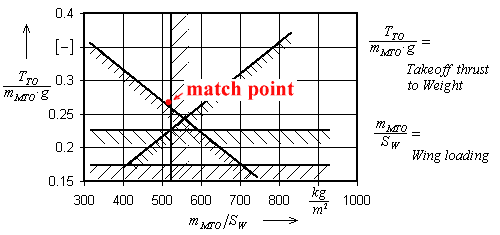
|
Introduction
|
Today an aircraft has to fulfil many different requirements and constraints to be effective and cost-favourable.
According to a preliminary sizing process for aircraft, introduced by LOFTIN 1980, at first
five major requirements will be solved and second the coincide of it result the definite aircraft parameters.
 Reqirements
Reqirements
1. landing field length
This requirement gives an upper value of the wing loading mMTO /SW.
Needed values are the maximum landing lift coefficient cL,max,L and the landing field
length sLFL according to JAR / FAR.
2. takeoff field length
Requirement takeoff field length gives a minimum value of the ratio takeoff thrust to weight over wing loading.
Input values are the maximum takeoff lift coefficient cL,max,TO and the takeoff field
length sTOFL according to JAR / FAR.
3. second segment climb
The second segment climb gives a minimum value of the ratio takeoff thrust to weight. Input is the lift to drag
ratio L / D .
4. missed approach climb
The missed approach climb gives a minimum value of the takeoff thrust to weight ratio. Needed valus are the lift
to drag ratio L / D and the ratio landing to takeoff mass mL / m
MTO.
5. cruise
The cruise requirement gives a minimum of the ratio takeoff thrust to weight over wing loading. Input values are
the Mach number Ma, the design lift-coefficient cL,Design and the maximum lift to
drag ratio (L / D)max.
 Coincide of Parameters
Coincide of Parameters
All requirements yield a graph to a two dimensional matching chart.

Figure 1: matching chart
example Wing loading mMTO /S
W and the take off thrust to weight ratio TTO /mMTO g
can be determined and further the parameters: maximum takeoff mass mMTO, operating empty
mass mOE, fuel mass mF and wing area SW.


